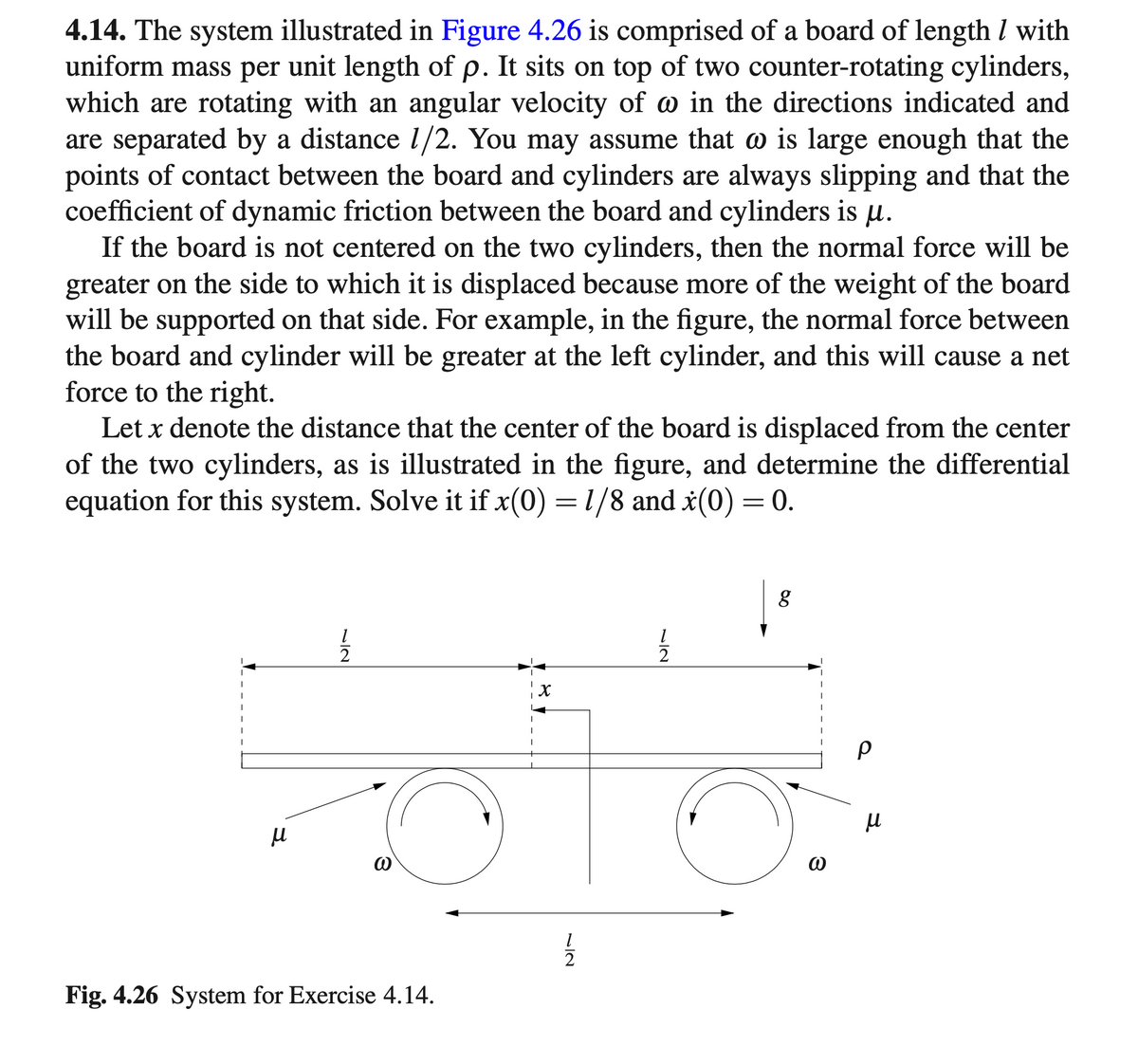4.14. The system illustrated in Figure 4.26 is comprised of a board of length / with uniform mass per unit length of p. It sits on top of two counter-rotating cylinders, which are rotating with an angular velocity of w in the directions indicated and are separated by a distance 1/2. You may assume that w is large enough that the points of contact between the board and cylinders are always slipping and that the coefficient of dynamic friction between the board and cylinders is u. If the board is not centered on the two cylinders, then the normal force will be greater on the side to which it is displaced because more of the weight of the board will be supported on that side. For example, in the figure, the normal force between the board and cylinder will be greater at the left cylinder, and this will cause a net force to the right. Let x denote the distance that the center of the board is displaced from the center of the two cylinders, as is illustrated in the figure, and determine the differential equation for this system. Solve it if x(0) = 1/8 and x(0) = 0.
4.14. The system illustrated in Figure 4.26 is comprised of a board of length / with uniform mass per unit length of p. It sits on top of two counter-rotating cylinders, which are rotating with an angular velocity of w in the directions indicated and are separated by a distance 1/2. You may assume that w is large enough that the points of contact between the board and cylinders are always slipping and that the coefficient of dynamic friction between the board and cylinders is u. If the board is not centered on the two cylinders, then the normal force will be greater on the side to which it is displaced because more of the weight of the board will be supported on that side. For example, in the figure, the normal force between the board and cylinder will be greater at the left cylinder, and this will cause a net force to the right. Let x denote the distance that the center of the board is displaced from the center of the two cylinders, as is illustrated in the figure, and determine the differential equation for this system. Solve it if x(0) = 1/8 and x(0) = 0.
Elements Of Electromagnetics
7th Edition
ISBN:9780190698614
Author:Sadiku, Matthew N. O.
Publisher:Sadiku, Matthew N. O.
ChapterMA: Math Assessment
Section: Chapter Questions
Problem 1.1MA
Related questions
Question

Transcribed Image Text:4.14. The system illustrated in Figure 4.26 is comprised of a board of length / with
uniform mass per unit length of p. It sits on top of two counter-rotating cylinders,
which are rotating with an angular velocity of @ in the directions indicated and
are separated by a distance 1/2. You may assume that is large enough that the
points of contact between the board and cylinders are always slipping and that the
coefficient of dynamic friction between the board and cylinders is μ.
If the board is not centered on the two cylinders, then the normal force will be
greater on the side to which it is displaced because more of the weight of the board
will be supported on that side. For example, in the figure, the normal force between
the board and cylinder will be greater at the left cylinder, and this will cause a net
force to the right.
Let x denote the distance that the center of the board is displaced from the center
of the two cylinders, as is illustrated in the figure, and determine the differential
equation for this system. Solve it if x(0) = 1/8 and x(0) = 0.
μ
72
@
Fig. 4.26 System for Exercise 4.14.
1/1/2
g
3
Р
и
Expert Solution
This question has been solved!
Explore an expertly crafted, step-by-step solution for a thorough understanding of key concepts.
This is a popular solution!
Trending now
This is a popular solution!
Step by step
Solved in 8 steps with 2 images

Knowledge Booster
Learn more about
Need a deep-dive on the concept behind this application? Look no further. Learn more about this topic, mechanical-engineering and related others by exploring similar questions and additional content below.Recommended textbooks for you

Elements Of Electromagnetics
Mechanical Engineering
ISBN:
9780190698614
Author:
Sadiku, Matthew N. O.
Publisher:
Oxford University Press

Mechanics of Materials (10th Edition)
Mechanical Engineering
ISBN:
9780134319650
Author:
Russell C. Hibbeler
Publisher:
PEARSON

Thermodynamics: An Engineering Approach
Mechanical Engineering
ISBN:
9781259822674
Author:
Yunus A. Cengel Dr., Michael A. Boles
Publisher:
McGraw-Hill Education

Elements Of Electromagnetics
Mechanical Engineering
ISBN:
9780190698614
Author:
Sadiku, Matthew N. O.
Publisher:
Oxford University Press

Mechanics of Materials (10th Edition)
Mechanical Engineering
ISBN:
9780134319650
Author:
Russell C. Hibbeler
Publisher:
PEARSON

Thermodynamics: An Engineering Approach
Mechanical Engineering
ISBN:
9781259822674
Author:
Yunus A. Cengel Dr., Michael A. Boles
Publisher:
McGraw-Hill Education

Control Systems Engineering
Mechanical Engineering
ISBN:
9781118170519
Author:
Norman S. Nise
Publisher:
WILEY

Mechanics of Materials (MindTap Course List)
Mechanical Engineering
ISBN:
9781337093347
Author:
Barry J. Goodno, James M. Gere
Publisher:
Cengage Learning

Engineering Mechanics: Statics
Mechanical Engineering
ISBN:
9781118807330
Author:
James L. Meriam, L. G. Kraige, J. N. Bolton
Publisher:
WILEY